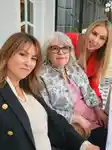
As the daughter of a Chilean immigrant, I often longed to connect with that part of my family growing up in Australia. One of the ways I found this connection was through the universal language of beauty.
My mum and grandparents would share stories about their journey to Australia, the challenges of learning a new language, finding their community, and adjusting to a new life. Yet, as a young woman trying to understand my own place in the world, what resonated most deeply with me was something more subtle: the beauty rituals that tied the women in my family together.

As the daughter of a Chilean immigrant, I often longed to connect with that part of my family growing up in Australia. One of the ways I found this connection was through the universal language of beauty.
My mum and grandparents would share stories about their journey to Australia, the challenges of learning a new language, finding their community, and adjusting to a new life. Yet, as a young woman trying to understand my own place in the world, what resonated most deeply with me was something more subtle: the beauty rituals that tied the women in my family together.


I grew up hearing about the brands my great-grandmother loved. The nostalgic scent of her favourite red lipstick, her cherished moisturiser, and the hand cream she never went without. These products, along with beauty tips and rituals, were passed from her to my grandmother, then to my mum, and now to me. They became more than just routines; they were living threads that connected me to my heritage, my culture, and the women who shaped me.
While I continue to learn about my family’s history and what made them who they are, I treasure this insight into their beauty rituals. I love that the same brands and practices they adored decades ago are still available today, bridging oceans and generations.

I grew up hearing about the brands my great-grandmother loved. The nostalgic scent of her favourite red lipstick, her cherished moisturiser, and the hand cream she never went without. These products, along with beauty tips and rituals, were passed from her to my grandmother, then to my mum, and now to me. They became more than just routines; they were living threads that connected me to my heritage, my culture, and the women who shaped me.
While I continue to learn about my family’s history and what made them who they are, I treasure this insight into their beauty rituals. I love that the same brands and practices they adored decades ago are still available today, bridging oceans and generations.
To some, beauty may seem trivial. But I believe it holds meaning. It shapes stories, carries knowledge, and preserves connection. For me, it has always been more than skin deep. It has been a way to understand myself, to connect with my four sisters as we swap beauty tips, and to bond with friends and acquaintances in conversations that often lead to deeper discussions.
Beauty, at its heart, is about more than a swipe of lipstick. It’s about identity, history, connection, and the rituals that remind us of who we are and where we come from.

To some, beauty may seem trivial. But I believe it holds meaning. It shapes stories, carries knowledge, and preserves connection. For me, it has always been more than skin deep. It has been a way to understand myself, to connect with my four sisters as we swap beauty tips, and to bond with friends and acquaintances in conversations that often lead to deeper discussions.
Beauty, at its heart, is about more than a swipe of lipstick. It’s about identity, history, connection, and the rituals that remind us of who we are and where we come from.

Less than 1% of recorded history is about women. As we built the MECCA Archive, the silences in beauty’s story became even clearer. So we put a call out to our MECCA community to help fill them – celebrating the rituals, products and personal histories that have shaped who we are. Here’s one of those beautiful contributions.
Our quest continues – help us write beauty’s next chapter by sharing your own reflections, rituals and memories here.


